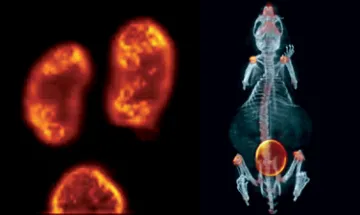Date Published: November 24, 2014
Nuclear imaging modalities, such as positron emission tomography and single-photon emission computed tomography, form an important element of modern medical diagnostics. The University of Arizona Center for Gamma-Ray Imaging, led by Harrison H. Barrett in cooperation with Lars R. Furenlid, Matthew A. Kupinski and Eric W. Clarkson, focuses on advancing the state of the art in radionuclide imaging (e.g., PET and SPECT). The CGRI uniquely combines rigorous theory, inventive computational tools, advanced detectors and electronics, innovative imaging systems, novel radiotracers and cutting-edge clinical and preclinical applications. This work is done within the context of gamma-ray imaging, but it is important to other forms of medical imaging and image science in general.

Left: High-resolution mouse kidney and bladder SPECT image acquired with cadmium-zinc-telluride gamma-ray pixel detectors. Right: Coregistered mouse SPECT/CT image acquired with FastSPECT II and FaCT (adaptive X-ray computed tomography) systems.
The collaborative research supported by the CGRI applies these new imaging tools to basic research in functional genomics, cardiovascular disease and cognitive neuroscience, and to research in breast cancer and surgical tumor detection. An exciting direction of research in the center is examining multimodal and adaptive imaging systems. A multimodal imaging system becomes adaptive when the information from one system is used to modify a second system before data is taken with it. For example, the first system (MRI or computerized tomography) may be used to locate regions of abnormalities, and then the second system (SPECT or PET) can be modified to focus on these regions for functional imaging.
They also specialize in developing and applying advanced X-ray and gamma-ray detectors and commissioned SPECT, PET and X-ray CT imaging systems. They study the physics of scintillation and solid-state detectors and the design of pulse-processing electronics, digital data-acquisition systems, and data inversion and reconstruction with a variety of computational methods.
